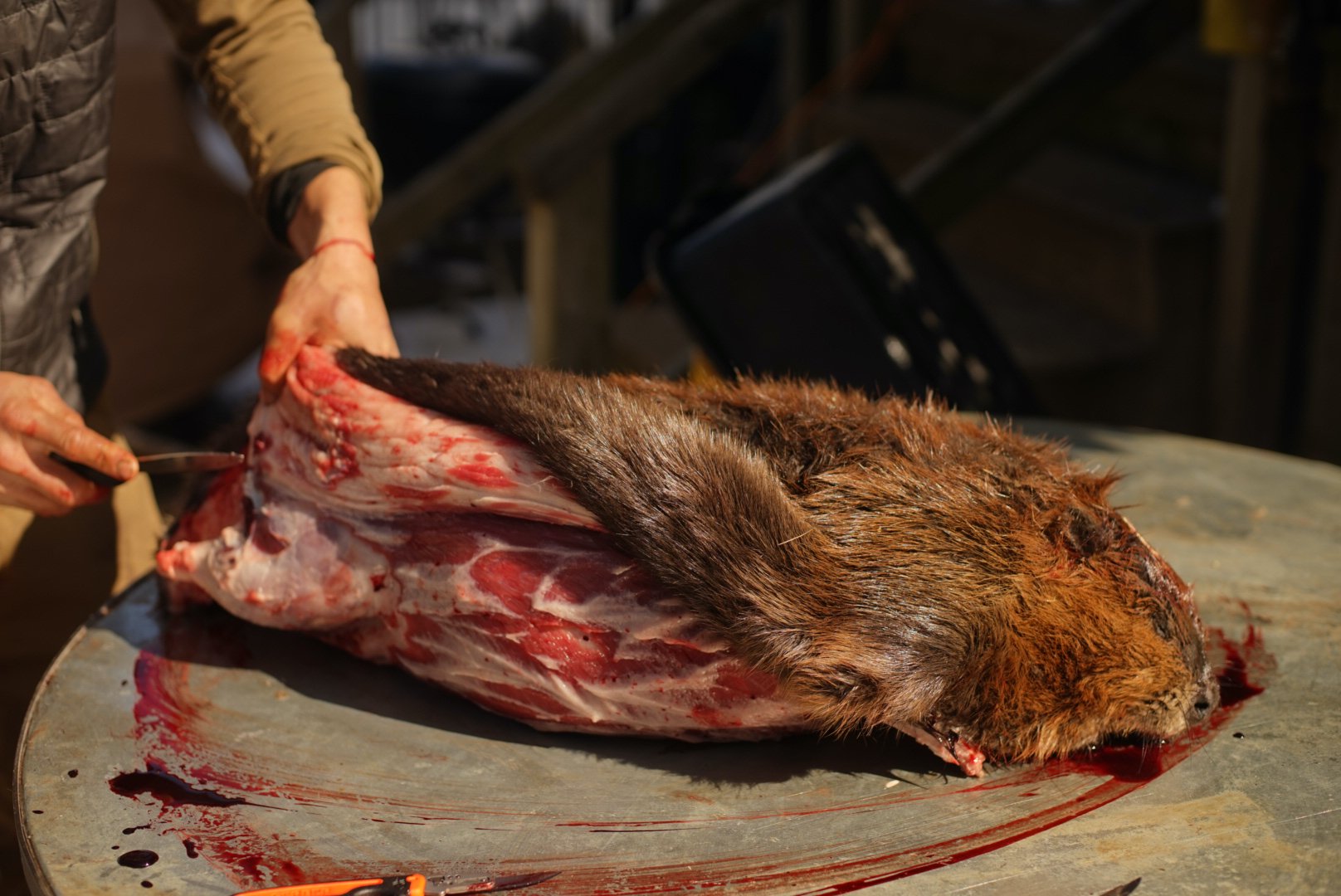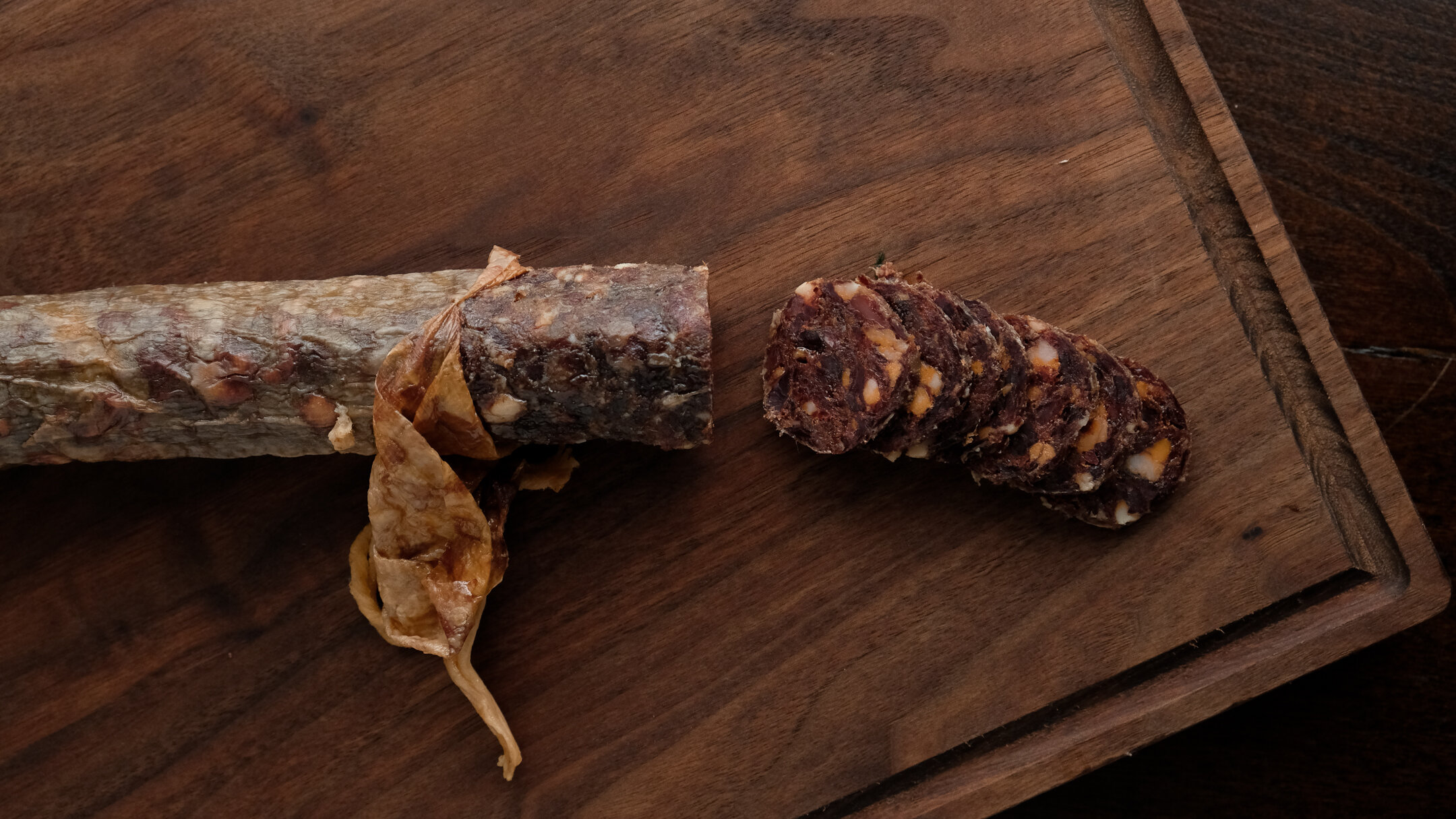Beaver Proscuitto

It’s super cool when a project that you’re uncertain about turns out well. And when that project involves a year of wait time and a whole bunch of priceless wild game meat, it’s even cooler. I sometimes feel like we’re walking a tightrope with a few of the recipes we’ve done- always trying to push the envelope a little, but also knowing that if we fail, we’re wasting some really hard earned protein.
So last February, when we applied salt, wine, and a mixture of lard and flour called “strutto” to a pair of beaver hindquarters and left them in the back of the curing chamber for a whole year, we were a little anxious about the whole thing. We’d had a decent trapping season, but nothing crazy, and we could think of a thousand different ways to use that meat. If it didn’t turn out, we were going to have to live with it- not just the fact that we’d wasted two perfectly good quarters, but also the lost opportunity to do something else with it.
They looked beautiful going into the chamber. The salt box cure method couldn’t be any easier, and after they’d been coated in strutto and hung from the hooks, they looked as good as anything you’d see hanging in a cheese shop window. Once in the chamber, we periodically checked them for mold, but otherwise just waited and let them be.
We pulled the first one after about 8 months to taste test- that one never made it back to the chamber. “Just a taste” turned into the two of us standing at the kitchen counter, carving slices from it until there was nothing left but the bone. It was amazing then and there, but we like our charcuteries with a little more weight loss and funk, so we put the other one back in to finish drying. The second one made it the full 12 months before we scraped the fat off of it and sliced into it.
This ham is amazing. The color, texture, and flavor is really only comparable to other fine hams- spanish Iberico comes to mind. It’s rich and a little woodsy, almost nutty, with a fine grain and excellent texture. This project was a test of a lot of things- our patience, the curing chamber we built, a centuries old technique and the quality of beaver meat. We were fairly confident in our understanding of dry curing meats, but this was our first year-long project, and we’re elated that it worked out the way it did.
As with most dry cured products, the quality of the meat is amplified over time and through moisture loss. The ham we tasted 8 months earlier was great, but the 12 month one is exceptional. Beaver meat is truly an amazing protein.
This recipe is more of a technique. At its core, this project is simply meat, salt and time. There are some extra steps in there that we like- rubbing the ham with wine just feels good, and using the strutto to cover the meat (in lieu of having pork skin to keep the ham from over drying) makes this work well with beaver. But at the end of the day, this is meat and salt. It’s a beautifully simple process, yet it yields some of the most complex and nuanced flavors you can experience. It's a testament to the quality of the meat, and a tribute to the animal that provided it.
Beaver Proscuitto
Prep time: 1 hour
Cure time: 6 months- 1 year
Ingredients:
Beaver hindquarters
Salt
White wine
Lard
Flour
Method:
Salt box the beaver ham. Pour a layer of salt in a container large enough for the ham. Place the ham on the layer of salt, then cover it with salt. Rub salt into all sides of the meat. Rotate and continue until the ham will not take any more salt.
Place the ham in a non-reactive container and add another layer of salt. Place a board over the ham and weigh it down with something heavier than the ham itself.
Refrigerate for 2 days per pound of ham (if doing multiples, base it off the largest ham).
Make sure ham is covered in salt through this curing stage. Drain off liquid daily and apply more salt as needed. The ham is cured when the color is dark and it’s firm to the touch (at approximately 10% weight loss).
When it’s done salt curing, rinse with cold water to remove remaining salt. Pat dry and rub with white wine.
Hang in the curing chamber for about a week until the outside starts to dry out a bit. It should feel tacky but not dry. Apply strutto (50:50 lard and flour mixture) to cover all parts of the ham.
Hang for 6-12 months in the curing chamber. At 6 months, the ham will have a milder flavor and more moisture. If left for the full 12 months, the ham will be funkier, in a good way, and have a slightly dryer consistency. If you’re unsure of how long to hang it, you can take it down at the halfway mark, slice into it for a taste, and then re-cover with strutto to hang longer if you wish.
Scrape off strutto and slice thinly.

















